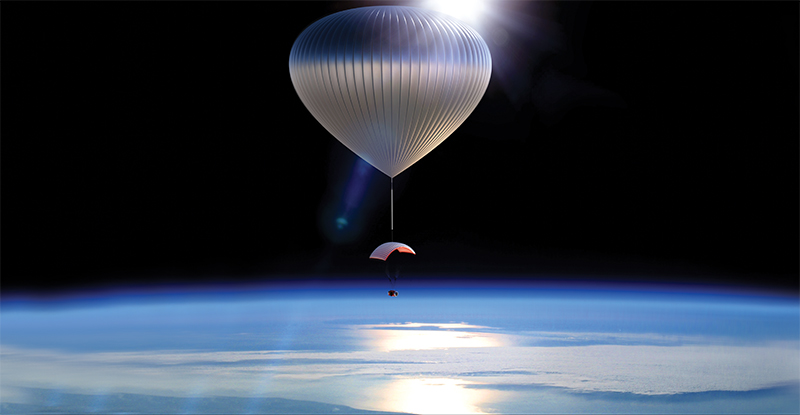
Air Revitalization System Enables Excursions to the Stratosphere
NASA Technology
In order to test a parachute system for surviving high-altitude bailouts, from 1959 to 1960 the US Air Force commenced Project Excelsior. It required Captain Joseph Kittinger to complete a series of jumps from a gondola tethered to a helium balloon that had carried him into the stratosphere. On August 16, 1960, Kittinger completed his most audacious leap from a height of 102,800 feet—until recently the highest altitude reached by man in an unpowered aircraft. After achieving a freefall velocity of 714 miles per hour, he landed safely back on New Mexico soil.
Kittinger’s risky skydive proved useful for not only pilots but also NASA astronauts. Besides the parachute, Kittinger also wore a pressurized suit to withstand being above what’s known as the Armstrong limit. At approximately 62,000 feet, or roughly 12 miles above Earth’s surface, atmospheric pressure drops so low that water boils at temperatures as low as the human body’s. The pressurized suit prevented Kittinger’s bodily fluids from doing the same, and its design also helped inform NASA’s early space suits, which protect astronauts from the same dangers in space.
Another of Kittinger’s contributions to space exploration was his participation in Project Manhigh, an Air Force program carried out just before Project Excelsior that studied the impacts that high altitudes have on helium balloons, aircraft, and human health. The research was an early inquiry into space exploration; the resulting findings laid the groundwork for NASA’s missions in the 1960s and beyond.
Now there’s a new story in the works that builds on the nation’s history with high-flying balloons and space travel, and it involves allowing others the opportunity to see the world from a view that only a select few, such as Kittinger, have ever been allowed to see.
The first chapter began as one of NASA’s iconic missions, the Space Shuttle Program, was coming to an end. The agency had set its sights on new horizons, such as sending humans to Mars and designing other spacecraft to explore the deeper reaches of the solar system. Instead of using the shuttle to get to the International Space Station (ISS), astronauts would hitch rides with the Russian Soyuz spacecraft. But the space agency recognized an opportunity for the private sector to eventually fill that transport role, and as a result, in 2009 NASA began accepting proposals under its Commercial Crew Development (CCDev) program.
Under CCDev, the agency paid companies to develop privately operated space vehicles and supporting technologies that would be used for low-Earth orbit missions such as trips to the ISS. One such supporting technology critical to astronaut survival in space is an air revitalization system. The air onboard a spacecraft must constantly be scrubbed of impurities and excess metabolic substances, so the shuttles were equipped with several components—housed in separate compartments—that removed carbon dioxide, carbon monoxide, and even humidity buildup from human sweat. Other technologies were used to control the room temperature and cycle air around to prevent it from stagnating.
To improve the safety, reliability, and affordability of privately operated space vehicles while simplifying the integration process, Tucson-based Paragon Space Development Corporation, which was already working with NASA to develop next-generation space suits, proposed combining all of those discrete functions into a single, dependable module that could be installed onto any commercial spacecraft. The agency accepted the proposal, and in 2010 the two entities entered into a Space Act agreement.
Ten months later, the company announced completion of the preliminary design of the Commercial Crew Transport-Air Revitalization System, or CCT-ARS. The CCT-ARS is an all-purpose unit containing seven life-sustaining modules: carbon dioxide removal, trace contaminant removal, air filtration, post-fire atmospheric recovery, cabin air circulation, a dehumidifier, and air temperature control. The key innovation lies in the fact that, with the use of patent-pending technology, only one moving part is involved—a fan that circulates the air through all the modules.
Technology Transfer
While the CCT-ARS was made for future manned flights into space, the air purification system’s modular design and cost-effectiveness has been successfully transferred to other industries, for instance, as a life support component for refuge chambers that sustain miners in the event of an underground disaster (Spinoff 2013). For its part, the leadership at Paragon, through the creation of a separate company, Tucson-based World View Enterprises Inc. is taking advantage of that technology, a favorable regulatory environment, and a rise in adventure tourism to send passengers, literally, into rarified air.
The concept is simple. At a launch site, likely in Page, Arizona, customers will board a pressurized capsule fitted with the CCT-ARS and attached to a large polyethylene balloon filled with helium. Two crewmembers onboard will guide the craft to heights of about 100,000 feet, at which point passengers will experience the same kinds of views Kittinger once beheld. After a few hours, the capsule will descend gently back to Earth. The experience takes an entire day.
Not only does World View use the CCT-ARS, which provides clean air throughout the duration of the flight, the firm also uses another technology that Paragon developed through NASA’s Small Business Innovation Research (SBIR) program: a single-loop radiator. “The advantage is that you have all of your pumps and valves and control systems inside the pressure vessel, so they’re accessible by the crew,” says Taber MacCallum, who is both chief executive officer at Paragon and chief technology officer at World View. “It’s simpler and also takes less energy to operate than standard radiators.”
MacCallum says NASA’s fingerprints can also be found throughout the rest of the vehicle. “Virtually every aspect of the World View spacecraft can be traced to NASA, from radiation-tolerant computers to the micro-meteoroid impact-tolerant design of the pressure vessel.”
What’s more, the agency has also contributed heavily to the ballooning technology that makes physically getting to that altitude possible. “NASA has been flying high-altitude balloons with payloads in the 8,000- to 10,000-pound range to very high altitudes for a long time,” MacCallum says, “and really helped develop some of the testing and launching methods, as well as the aerodynamics of how a vehicle flies back from the edge of space.”
Benefits
What does Earth look like from 100,000 feet up? According to the World View website, as one ascends, everything on the ground—the trees, buildings, even the mountains—blends into a beautiful collage. Through the capsule’s dramatic windows, the roundness of Earth is also clear to see, as well as its position within a vast universe. To enhance the experience, the journey begins before dawn so the passengers can observe the night sky as well as the sunrise.
Apparently, the latter has even gotten astronauts excited. “Some of them I’ve spoken to really think it would be a nice experience to watch the sunrise occur from this frontier of space,” MacCallum says, noting that astronauts in orbit circle Earth every 90 minutes. They’re only allowed a glimpse of places before they zoom by. “They think it would be a different experience to watch the sun and see the clouds forming from one location.”
In addition to these once-in-a-lifetime experiences, there are also science research opportunities to be had onboard the capsule. For example, microbiology and celestial observing applications could benefit from an environment nearly devoid of atmosphere.
“Certainly, we could carry payloads outside,” MacCallum says, “and maybe we’ll end up doing dedicated science flights that have a lot of instrumentation inside or outside facing the window or attached to the outside of the capsule. We’re starting at 100,000 feet, but certainly other altitudes are also possible.”
World View is pushing to take its inaugural commercial flight by the end of 2016, and a number of tickets have already sold. The introductory price is steep at $75,000, but it compares favorably to similar services: Virgin Galactic, for example, is offering a suborbital spaceflight experience for $250,000.
“A big part of the timing is that the demographics are good in terms of the number of people having the financial wherewithal to take a trip like this,” MacCallum says. “And when you consider the aeronautics and space community’s history with Kittinger’s jump and the Manhigh program, it’s like we’re returning to our roots.”
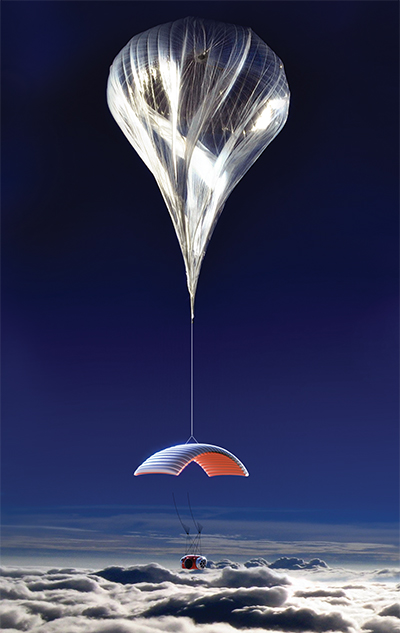
Lifting the World View capsule into the stratosphere is a helium-filled, high-altitude balloon that has its roots in NASA technology. The agency developed standardized testing and launching methods and contributed research to understanding the aerodynamics of how objects descend to Earth from the edge of space.
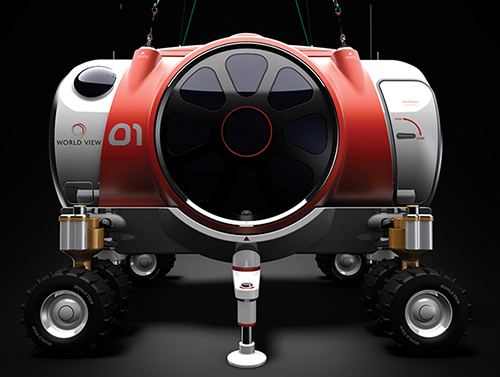
The Commercial Crew Transport-Air Revitalization System was originally developed for future use on manned missions to the International Space Station (ISS), but World View is using the technology in its capsule to keep crew and passengers safe and comfortable throughout the unique experience.
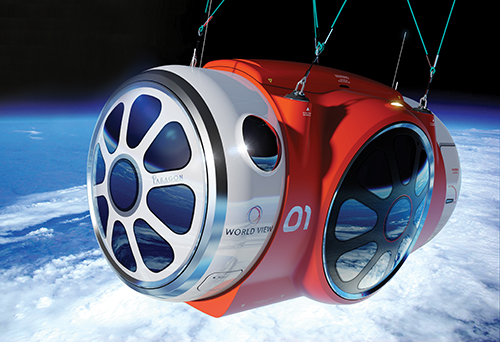
The cabin is a pressure vessel similar in design to the modules that form the living and working quarters of the ISS. Inspired by the space station's cupola, the expansive windows allow for maximum viewing.
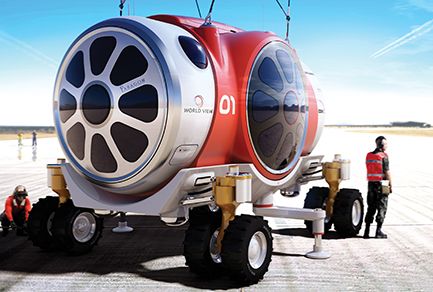
The plan is for the capsule to launch and return to Page, Arizona, where winds are calm. Passengers will also be treated to breathtaking views of the Grand Canyon during descent.

Passengers will ascend 100,000 feet above the ground, high enough to see the curvature of Earth and picture its existence in a vast universe. Because the capsule will take off in the early morning, passengers will also be able to take in views of both the nighttime sky and the sunrise.













